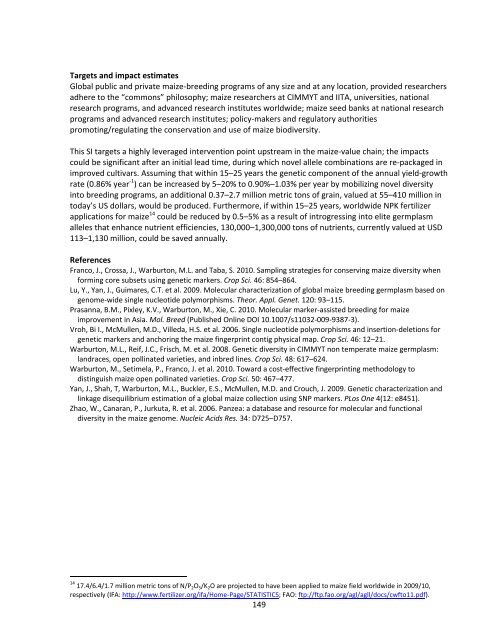Download - Maize
Download - Maize
Download - Maize
Create successful ePaper yourself
Turn your PDF publications into a flip-book with our unique Google optimized e-Paper software.
Targets and impact estimates<br />
Global public and private maize‐breeding programs of any size and at any location, provided researchers<br />
adhere to the “commons” philosophy; maize researchers at CIMMYT and IITA, universities, national<br />
research programs, and advanced research institutes worldwide; maize seed banks at national research<br />
programs and advanced research institutes; policy‐makers and regulatory authorities<br />
promoting/regulating the conservation and use of maize biodiversity.<br />
This SI targets a highly leveraged intervention point upstream in the maize‐value chain; the impacts<br />
could be significant after an initial lead time, during which novel allele combinations are re‐packaged in<br />
improved cultivars. Assuming that within 15–25 years the genetic component of the annual yield‐growth<br />
rate (0.86% year ‐1 ) can be increased by 5–20% to 0.90%–1.03% per year by mobilizing novel diversity<br />
into breeding programs, an additional 0.37–2.7 million metric tons of grain, valued at 55–410 million in<br />
today’s US dollars, would be produced. Furthermore, if within 15–25 years, worldwide NPK fertilizer<br />
applications for maize 14 could be reduced by 0.5–5% as a result of introgressing into elite germplasm<br />
alleles that enhance nutrient efficiencies, 130,000–1,300,000 tons of nutrients, currently valued at USD<br />
113–1,130 million, could be saved annually.<br />
References<br />
Franco, J., Crossa, J., Warburton, M.L. and Taba, S. 2010. Sampling strategies for conserving maize diversity when<br />
forming core subsets using genetic markers. Crop Sci. 46: 854–864.<br />
Lu, Y., Yan, J., Guimares, C.T. et al. 2009. Molecular characterization of global maize breeding germplasm based on<br />
genome‐wide single nucleotide polymorphisms. Theor. Appl. Genet. 120: 93–115.<br />
Prasanna, B.M., Pixley, K.V., Warburton, M., Xie, C. 2010. Molecular marker‐assisted breeding for maize<br />
improvement in Asia. Mol. Breed (Published Online DOI 10.1007/s11032‐009‐9387‐3).<br />
Vroh, Bi I., McMullen, M.D., Villeda, H.S. et al. 2006. Single nucleotide polymorphisms and insertion‐deletions for<br />
genetic markers and anchoring the maize fingerprint contig physical map. Crop Sci. 46: 12–21.<br />
Warburton, M.L., Reif, J.C., Frisch, M. et al. 2008. Genetic diversity in CIMMYT non temperate maize germplasm:<br />
landraces, open pollinated varieties, and inbred lines. Crop Sci. 48: 617–624.<br />
Warburton, M., Setimela, P., Franco, J. et al. 2010. Toward a cost‐effective fingerprinting methodology to<br />
distinguish maize open pollinated varieties. Crop Sci. 50: 467–477.<br />
Yan, J., Shah, T, Warburton, M.L., Buckler, E.S., McMullen, M.D. and Crouch, J. 2009. Genetic characterization and<br />
linkage disequilibrium estimation of a global maize collection using SNP markers. PLos One 4(12: e8451).<br />
Zhao, W., Canaran, P., Jurkuta, R. et al. 2006. Panzea: a database and resource for molecular and functional<br />
diversity in the maize genome. Nucleic Acids Res. 34: D725–D757.<br />
14 17.4/6.4/1.7 million metric tons of N/P 2 O 5 /K 2 O are projected to have been applied to maize field worldwide in 2009/10,<br />
respectively (IFA: http://www.fertilizer.org/ifa/Home‐Page/STATISTICS; FAO: ftp://ftp.fao.org/agl/agll/docs/cwfto11.pdf).<br />
149

















